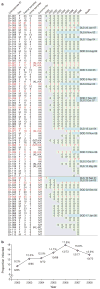Increased mortality and AIDS-like immunopathology in wild chimpanzees infected with SIVcpz
- PMID: 19626114
- PMCID: PMC2872475
- DOI: 10.1038/nature08200
Increased mortality and AIDS-like immunopathology in wild chimpanzees infected with SIVcpz
Abstract
African primates are naturally infected with over 40 different simian immunodeficiency viruses (SIVs), two of which have crossed the species barrier and generated human immunodeficiency virus types 1 and 2 (HIV-1 and HIV-2). Unlike the human viruses, however, SIVs do not generally cause acquired immunodeficiency syndrome (AIDS) in their natural hosts. Here we show that SIVcpz, the immediate precursor of HIV-1, is pathogenic in free-ranging chimpanzees. By following 94 members of two habituated chimpanzee communities in Gombe National Park, Tanzania, for over 9 years, we found a 10- to 16-fold higher age-corrected death hazard for SIVcpz-infected (n = 17) compared to uninfected (n = 77) chimpanzees. We also found that SIVcpz-infected females were less likely to give birth and had a higher infant mortality rate than uninfected females. Immunohistochemistry and in situ hybridization of post-mortem spleen and lymph node samples from three infected and two uninfected chimpanzees revealed significant CD4(+) T-cell depletion in all infected individuals, with evidence of high viral replication and extensive follicular dendritic cell virus trapping in one of them. One female, who died within 3 years of acquiring SIVcpz, had histopathological findings consistent with end-stage AIDS. These results indicate that SIVcpz, like HIV-1, is associated with progressive CD4(+) T-cell loss, lymphatic tissue destruction and premature death. These findings challenge the prevailing view that all natural SIV infections are non-pathogenic and suggest that SIVcpz has a substantial negative impact on the health, reproduction and lifespan of chimpanzees in the wild.
Figures




Comment in
-
Infectious diseases: An ill wind for wild chimps?Nature. 2009 Jul 23;460(7254):470-1. doi: 10.1038/460470a. Nature. 2009. PMID: 19626107 No abstract available.
References
-
- Hahn BH, Shaw GM, De Cock KM, Sharp PM. AIDS as a zoonosis: scientific and public health implications. Science. 2000;287:607–614. - PubMed
-
- Silvestri G. Immunity in natural SIV infections. J Intern Med. 2008;265:97–109. - PubMed
-
- Koopman G, Haaksma AG, ten Velden J, Hack CE, Heeney JL. The relative resistance of HIV type 1-infected chimpanzees to AIDS correlates with the maintenance of follicular architecture and the absence of infiltration by CD8+ cytotoxic T lymphocytes. AIDS Res Hum Retroviruses. 1999;15:365–373. - PubMed
-
- Gougeon ML, et al. Lack of chronic immune activation in HIV-infected chimpanzees correlates with the resistance of T cells to Fas/Apo-1 (CD95)-induced apoptosis and preservation of a T helper 1 phenotype. J Immunol. 1997;158:2964–2976. - PubMed
Publication types
MeSH terms
Associated data
- Actions
- Actions
- Actions
- Actions
- Actions
- Actions
- Actions
- Actions
- Actions
- Actions
- Actions
- Actions
- Actions
- Actions
- Actions
- Actions
- Actions
- Actions
- Actions
- Actions
- Actions
- Actions
- Actions
- Actions
- Actions
Grants and funding
- RR-00165/RR/NCRR NIH HHS/United States
- R37 AI050529/AI/NIAID NIH HHS/United States
- HHMI/Howard Hughes Medical Institute/United States
- P30 AI 27767/AI/NIAID NIH HHS/United States
- P51 RR000165/RR/NCRR NIH HHS/United States
- U19 AI067854/AI/NIAID NIH HHS/United States
- R01 AI058715/AI/NIAID NIH HHS/United States
- T32 GM008111/GM/NIGMS NIH HHS/United States
- R01 AI50529/AI/NIAID NIH HHS/United States
- HHSN266200400088C/PHS HHS/United States
- P30 AI027767/AI/NIAID NIH HHS/United States
- R01 AI58715/AI/NIAID NIH HHS/United States
- R01 AI050529/AI/NIAID NIH HHS/United States
LinkOut - more resources
Full Text Sources
Other Literature Sources
Molecular Biology Databases
Research Materials

